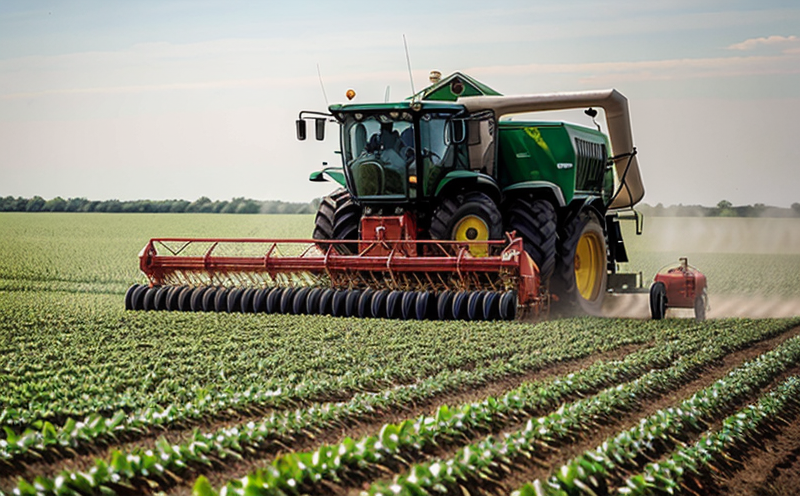Leaf Area Index Testing
The Leaf Area Index (LAI) is a crucial parameter in agriculture and forestry that quantifies the total surface area of foliage per unit of ground area. It plays a pivotal role in assessing plant canopy structure, which influences light interception, photosynthesis efficiency, and overall crop yield. In agricultural fields and forested areas, LAI testing provides valuable insights into how efficiently plants utilize light energy, aiding in optimizing planting density, irrigation schedules, and pest management practices.
Leaf Area Index is measured using various techniques depending on the scale of analysis—ranging from small plot studies to large-scale satellite imagery. For precision agriculture, handheld sensors are used for field-level assessments, while canopy analyzers offer more comprehensive data at a larger spatial extent. LAI can also be calculated mathematically based on the number of leaves and their dimensions.
In agricultural research, understanding LAI is essential for optimizing crop yields by ensuring optimal light exposure without overcrowding plants. In forestry applications, it helps in forest management practices such as thinning or fertilization to enhance growth rates and improve wood quality. Compliance officers can use this data to ensure sustainable land use practices align with environmental regulations.
The primary goal of LAI testing is not only to measure the current state but also to track changes over time, providing a longitudinal view on how different management strategies impact plant health and productivity. This information is invaluable for research institutions, farms, and forestry enterprises aiming to improve sustainability and yield efficiency.
| Scale | Methodology | Data Provided |
|---|---|---|
| Field Level | Handheld sensors | Individual plant LAI |
| Crop Canopy Analysis | Canopy Analyzers | Whole canopy LAI |
| Satellite Monitoring | Spectral Imaging | Large-scale LAI data |
In summary, Leaf Area Index Testing is a critical tool in agriculture and forestry that enables precision management of plant canopies to achieve optimal yields. Its application spans from small-scale field studies to large-scale satellite-based assessments, providing actionable insights for sustainable agricultural practices.
Why It Matters
The importance of Leaf Area Index Testing cannot be overstated in the context of sustainable agriculture and forestry. By accurately measuring LAI, we can better understand how plants utilize light energy, which is a key driver of photosynthesis and growth. This knowledge allows for more efficient resource allocation—such as water and nutrients—which ultimately leads to higher crop yields and healthier forests.
For agricultural fields, optimizing LAI can help in determining the optimal planting density that maximizes sunlight absorption without causing overcrowding. In forestry, managing LAI helps in decisions regarding thinning or fertilization practices to enhance growth rates and wood quality. This not only improves the productivity of the land but also contributes to environmental sustainability by promoting healthier ecosystems.
Moreover, LAI testing is critical for compliance officers who need to ensure that land use practices adhere to environmental regulations. By providing accurate data on canopy structure and light utilization, LAI testing supports sustainable agricultural and forestry management strategies.
The practical implications of this testing extend beyond just increasing yields; it also contributes to the broader goal of reducing carbon emissions by optimizing resource use in a way that minimizes waste and promotes ecological balance. This aligns with global efforts towards more sustainable practices across all sectors involved in agriculture and forestry.
Industry Applications
Leaf Area Index Testing finds extensive application across various industries within the agricultural and forestry sectors. Here are some key areas where LAI testing is particularly important:
| Crop Research & Development (R&D) | Assesses the effectiveness of new crop varieties in terms of their light interception capabilities. |
| Precision Agriculture | Guides farmers in making informed decisions about planting density and irrigation schedules to maximize yield while minimizing resource usage. |
| Agricultural Compliance & Regulatory Affairs | Ensures adherence to environmental regulations by providing accurate data on canopy structure, which helps in sustainable land use practices. |
| Forestry Management | Supports decisions related to thinning or fertilization practices aimed at enhancing growth rates and wood quality. |
| Environmental Monitoring | Tracks changes in LAI over time to assess the impact of climate change on vegetation health and productivity. |
| Pest Management & Disease Detection | Identifies areas of stress or disease by monitoring changes in LAI, which can indicate issues with plant health. |
| Climate Change Research | Provides baseline data on canopy structure that can be used to monitor the effects of climate change on vegetation. |
In each of these applications, LAI testing serves as a critical tool for making informed decisions that enhance productivity and sustainability. Its versatility makes it an indispensable part of modern agricultural and forestry practices.
International Acceptance and Recognition
The Leaf Area Index Testing methodology is widely recognized and accepted internationally, with standards set by reputable organizations such as the International Organization for Standardization (ISO) and the American Society for Testing and Materials (ASTM). These standards ensure consistency and reliability in LAI measurements across different regions and applications.
In agriculture, ISO 13049 provides guidelines for the measurement of leaf area index using various methods. This standard is crucial for ensuring that all measurements are conducted under controlled conditions to yield accurate results. Similarly, ASTM D7526 outlines procedures for determining LAI from remote sensing data, which is particularly useful in large-scale applications like satellite monitoring.
For forestry applications, the European Standard EN 14380 specifies methods for calculating LAI using ground-based and airborne techniques. This ensures that forest managers have consistent and comparable data when assessing canopy structure and light utilization within their forests.
The international recognition of these standards underscores the importance of LAI testing in both research and practical applications. Compliance with these standards not only enhances the accuracy of measurements but also facilitates effective communication among researchers, farmers, and policymakers across different countries and regions.





